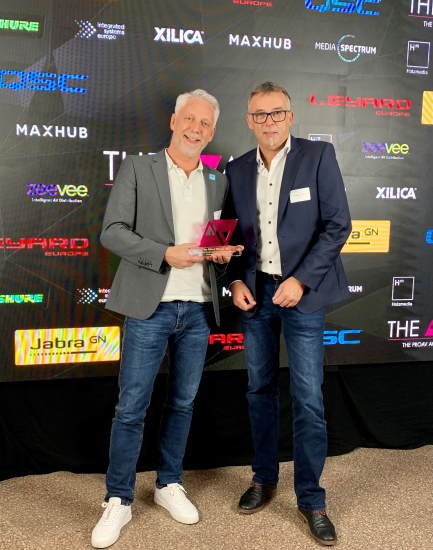Lawo’s HOME Platform and Zurich Opera’s IP Remote Production Project win Prestigious Awards

L-R: Martin Olff, Rainer Litfin
It has been an eventful start into the month of November for Lawo, which won two industry awards that recognize the most significant and promising new products and technologies.
First off was the “2021 NAB Show Product of the Year Award” in the category “IT Networking/Infrastructure & Security” for Lawo’s HOME Management Platform for IP-based Media Infrastructures. Launched in April, HOME is natively built on a cloud-ready microservices architecture, enabling users to connect, manage and secure networked production setups from the ground up. It provides centralized access and control for all Lawo gear within a setup. With HOME, the cloud starts on-campus, privately and locally. It turns an array of devices, setups, sites, hubs and data centers into a powerful, agile multi-site network - quickly and in a perfectly secure way. Inside HOME, discovery of devices is automatic, while registering and admitting them to the network is only a button press away. HOME helps broadcast professionals address some of the most demanding requirements of modern IP infrastructures, including automated discovery and registration of devices, connection management, flow control, software & firmware management, scalability and security.
“Nominees like Lawo are revolutionizing the way people experience media and entertainment,” said NAB Executive Vice President of Conventions and Business Operations Chris Brown. “The 2021 NAB Show Product of the Year Awards highlight the best of what’s new and celebrate the breakthroughs and advancements within the content industry.”
With its bold project to keep producing top-tier opera performances in adverse times, Zurich Opera secured an “AVard” for “Best Innovative Integration 2021”. Donated by the Ebner Media Group, the AVard is a “ProAV award in Germany that honors the best projects, products and minds.” To save its 2020-21 season, Zurich Opera used a Lawo IP-based, near-zero latency setup to physically separate musicians, the choir and soloists, while uniting them on a virtual level at the hall. The soloists on stage followed the conductor on a screen, and the orchestra was replaced by 10 speakers in the pit. Thanks to expert 3D audio mixing that included acoustic movements by the choir, the realism was stunning. No sound reinforcement was used for the soloists. A host of new experiences under the awe-inspiring technical stewardship of Oleg Surgutschow and Michael Utz have changed the perception of technology in a sector that is definitely no longer technology-averse.
“We received countless phone calls from other venues across the world, and I was asked to present the project to my peers at this year’s Tonmeistertagung in Germany,” explains Swiss-based Oleg Surgutschow, the head of Zurich Opera’s audio and video department. “The key to our success was to rely on Lawo consoles, V__remote4 units and RAVENNA. In addition, Michael Utz discovered that video latency can be minimized if all cameras are synchronized to the network.”
 How to resolve AdBlock issue?
How to resolve AdBlock issue?